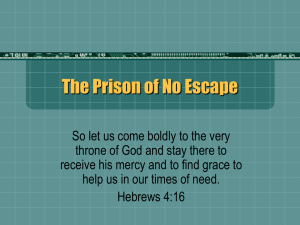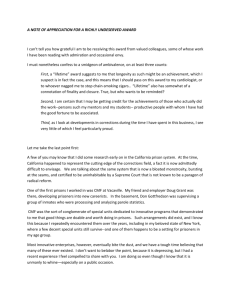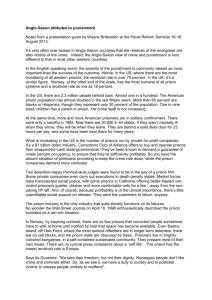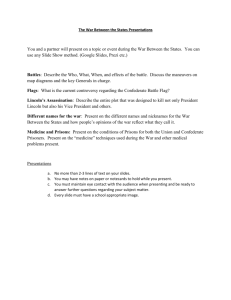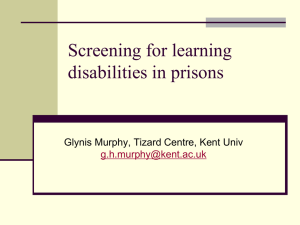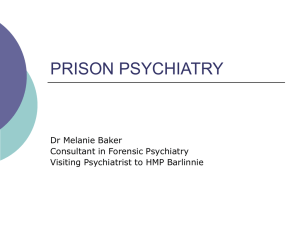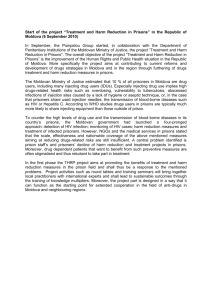“Castle Prison and Aldersgate Street: Converging
advertisement
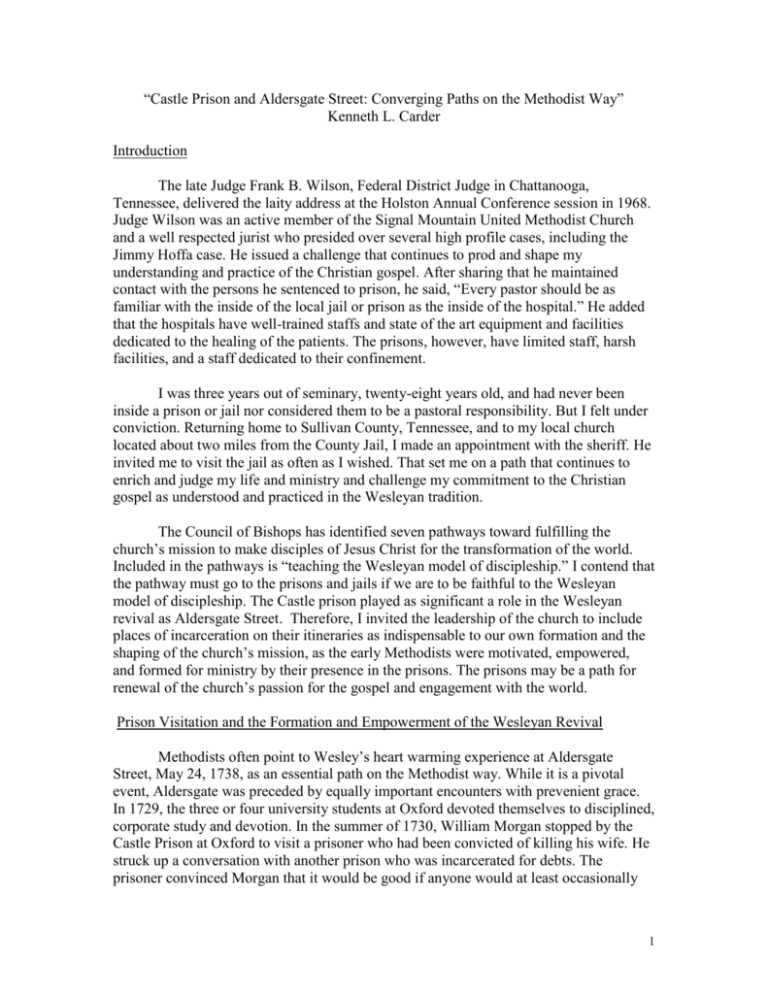
“Castle Prison and Aldersgate Street: Converging Paths on the Methodist Way” Kenneth L. Carder Introduction The late Judge Frank B. Wilson, Federal District Judge in Chattanooga, Tennessee, delivered the laity address at the Holston Annual Conference session in 1968. Judge Wilson was an active member of the Signal Mountain United Methodist Church and a well respected jurist who presided over several high profile cases, including the Jimmy Hoffa case. He issued a challenge that continues to prod and shape my understanding and practice of the Christian gospel. After sharing that he maintained contact with the persons he sentenced to prison, he said, “Every pastor should be as familiar with the inside of the local jail or prison as the inside of the hospital.” He added that the hospitals have well-trained staffs and state of the art equipment and facilities dedicated to the healing of the patients. The prisons, however, have limited staff, harsh facilities, and a staff dedicated to their confinement. I was three years out of seminary, twenty-eight years old, and had never been inside a prison or jail nor considered them to be a pastoral responsibility. But I felt under conviction. Returning home to Sullivan County, Tennessee, and to my local church located about two miles from the County Jail, I made an appointment with the sheriff. He invited me to visit the jail as often as I wished. That set me on a path that continues to enrich and judge my life and ministry and challenge my commitment to the Christian gospel as understood and practiced in the Wesleyan tradition. The Council of Bishops has identified seven pathways toward fulfilling the church’s mission to make disciples of Jesus Christ for the transformation of the world. Included in the pathways is “teaching the Wesleyan model of discipleship.” I contend that the pathway must go to the prisons and jails if we are to be faithful to the Wesleyan model of discipleship. The Castle prison played as significant a role in the Wesleyan revival as Aldersgate Street. Therefore, I invited the leadership of the church to include places of incarceration on their itineraries as indispensable to our own formation and the shaping of the church’s mission, as the early Methodists were motivated, empowered, and formed for ministry by their presence in the prisons. The prisons may be a path for renewal of the church’s passion for the gospel and engagement with the world. Prison Visitation and the Formation and Empowerment of the Wesleyan Revival Methodists often point to Wesley’s heart warming experience at Aldersgate Street, May 24, 1738, as an essential path on the Methodist way. While it is a pivotal event, Aldersgate was preceded by equally important encounters with prevenient grace. In 1729, the three or four university students at Oxford devoted themselves to disciplined, corporate study and devotion. In the summer of 1730, William Morgan stopped by the Castle Prison at Oxford to visit a prisoner who had been convicted of killing his wife. He struck up a conversation with another prison who was incarcerated for debts. The prisoner convinced Morgan that it would be good if anyone would at least occasionally 1 visit with them.1 Morgan then persuaded John and Charles Wesley to accompany him to the Castle Prison. Soon, they began visiting the prison once or twice each week. Before the year was out, they added the city prison, Bocardo, on their itinerary. Richard Heitzenrater says, “Thus began their program of outreach, which soon broadened to include visiting the sick, teaching the poor children, feeding the hungry, and reaching out to the needy in the city.”2 Thereby, the seeds for acts of mercy as indispensable means of grace were sown! When Samuel Wesley, John’s father, heard about his sons’ visits at the Castle Prison, he wrote words of encouragement. He indicated that he visited the same prison when he was an Oxford student. He added, “ . . . and [I] reflect on it with great satisfaction to this day.”3 It is well to remember that Samuel had personal experience as a prisoner, having served three or four months in Lincoln Castle Prison in 1705 for unpaid debts. Although John was only two years old, I wonder how many times that experience came up in conversations in the Epworth Rectory. The program of prison visitation expanded to include someone in the group visiting Castle and Bocardo prisons every day. Their ministry included conversation, reading to the prisons, praying with them, instructing them in Christian practices, conducting Prayer Services, and presiding over the Eucharist every Sunday.4 The work in the prisons grew and continued during the Wesley brothers’ tenure in Georgia. When Charles returned from Georgia, he added Newgate and Marshalsea prisons in London, Newgate in Bristol, and Cardiff prison in Wales.5 Eventually, John and Charles recruited several friends and followers for prison ministry. Most notable were Sarah Peters and Silas Told. Wesley became a friend of John Howard, one of the outspoken reformers of the prison system in England and spoke out publically against the inhumane conditions in many of the prisons.6 February through May, 1738 was a critical period in the Methodist movement. John Wesley returned from Georgia in late January 1738 dispirited, discouraged, and confronting a spiritual and vocational crisis. He had failed, which was a new experience for the high- achieving Oxford don and Anglican priest. He lacked the assurance of his own salvation and his confidence in the power of the gospel to transform lives was diminished by the absence of results in Georgia. He returned to Oxford and there follows in early March the pivotal encounter with Peter Bohler. His Journal entry for Saturday, March 4, reads as follows: I found my brother at Oxford, recovering from his pleurisy; and with him Peter Bohler. By whom (in the hand of the great God!) Richard P. Heitzenrater, “Prison Ministry in the Wesleyan Tradition,” in James M. Shopshire, Mark C. Hicks, and Richmond Stogin (editors), I Was in Prison: United Methodist Perspectives on Prison Ministry (Nashville: General Board of Higher Education and Ministry, The United Methodist Church, 2008), p. 67f. 2 Ibid, p. 68. 3 Ibid, p. 76. 4 Ibid, p. 68. 5 Ibid, p. 70. 6 Ibid, p.70. 1 2 I was on Sunday the 5th clearly convinced of unbelief, of the want of ‘that faith whereby alone we are saved’, with the full, Christian salvation. Immediately it stuck in my mind, ‘Leave off preaching. How can you preach to others, who have not faith yourself?’ I asked Bohler whether he thought I should leave it off or not. He answered, “By no means.’ I asked, ‘But what can I preach?’ He said, ‘Preach faith till you have it, and then, because you have it, you will preach faith.’7 The entry for March 6, 1738, is equally pivotal, although far less noted by interpreters of Wesley: “Accordingly, Monday 6, I began preaching this new doctrine, though my soul started back from the work. The first person to whom I offered salvation by faith alone was a prisoner under the sentence of death. His name was [William] Clifford. Peter Bohler had many times desired me to speak to him before. But I could not prevail on myself so to do, being still (as I had been for years) a zealous asserter of the impossibility of a death-bed repentance.8 It was the witness of the power of God to transform William Clifford, a death row inmate convicted of assault, burglary, and desertion that confirmed the validity of Bohler’s advice and offered promise to the restless Wesley that he might know this inner assurance of salvation, to which he gave personal witness May 24, 1738. Such confirmation of the witness of the Spirit in the prisons continued throughout the Wesleys’ engagement with inmates and condemned malefactors. The prisons of the eighteenth century were populated largely by two groups of inmates, debtors and those awaiting execution. There were more than two hundred capital offenses; not only murder, arson, rape, treason but also burglary, animal theft and malicious maiming of cattle. The Wesleys report many incidents of visiting prisoners sentenced to hanging and the impact on the condemned men and on John and Charles. April 2, 1739, marks the date when John Wesley first preached out of doors, an intentional turning toward the margins as the context of renewal. Three weeks later, April 25, 1739, John Wesley preached to the prisoners in Bristol’s Newgate Prison. He records this response: “I was insensibly led without any previous design to declare strongly and explicitly that ‘God willeth all men to be saved.’ Immediately one, and another, and another sunk to the ground on every side as thunderstruck.”9 Charles Wesley’s Journal for July 1738 documents his ministry in Bristol. On the night before the execution of nine prisoners, “We wrestled in mighty prayer . . . Joy was visible in all their faces. We sang ‘Behold the Savior of Mankind: Nailed to the shameful tree. How vast the love that him inclined, To bleed and die for thee.’ It was one of the most triumphant hours I have known.” The next morning he accompanied them to the gallows: “They were all cheerful, 7 Journal, Works, V. I, page 228. Ibid, p. 228. 9 Journal, Works, V. II, p. 8 3 full of comfort, peace and triumph, assuredly persuaded that Christ had died for them and waited to receive them into paradise … I never saw such calm triumph, such incredible indifference to dying.” He returned home, “Full of peace and confidence in our friends’ happiness. That hour under the gallows was the most blessed hour of my life.”10 Now, that response is somewhat problematic and merits candid theological analysis. Regrettably, the Methodists, including John and Charles Wesley, failed to pursue the theological implications of their experiences with prisoners, especially the condemned malefactors. While we applaud and benefit from their witness to those sentenced to death, we wonder why they did not reflect more on the implications of their affirmation of the imago Dei and holistic salvation on a system that considered the death penalty an acceptable punishment for even petty crimes.11 While they spoke out against the deplorable conditions in the prisons and joined John Howard in advocating prison reform, the Wesleys had too little to say about the unjust and class-dominated system of justice and its impact of prisoners families and English society. It is important to note that these incidents mentioned above took place within months of John Wesley’s Aldersgate experience and the beginning of ‘field preaching’. They served to reinforce Wesley’s commitment to radical incarnational presence on the margins of society and an assurance of the presence and power of God (grace) to transform human hearts. Those experiences set the Methodists on a pathway that spanned the eighteenth century. Castle Prison and Aldersgate Street converged: acts of mercy and acts of piety, the witness of the Spirit and engagement in mission. So, the Methodists’ involvement in prison ministry helped to empower the movement and shape its theology, liturgy, and practice; and it laid the foundation for further theological reflection and missional engagement. In addition to being the locus of the witness of the Spirit to the efficacy of God’s grace to radically transform persons, it confirmed the importance of a radical incarnational presence among the marginalized of society. Wesley considered visiting the poor, the sick, and the imprisoned as an indispensable means of grace to both the visitor and the visited. In fact, he considered such acts of mercy as having priority and as a means to greater sanctification. In his letter to Miss March, a polite and affluent woman who was hesitant to visit the poor, Wesley wrote in 1776: Aim at love and you will not stop at the threshold of perfection. There are many blessings in life, but how do you improve them to the glory of God? And are you willing to know? Then I will tell you how. Go and see the poor and such in their own poor little hovels. Take up your cross, woman! Remember the faith! Jesus went before you, and will go with you. Put off the gentlewoman. You bear a higher character.12 10 Cf. Journal of Charles Wesley and P. Linebaugh, The London Hanged: Crime and Civil Society in the Eighteenth Century (Harmondsworth, Penguin, 1991), pp. 214-215. 11 Wesley does record an anecdote from August 23, 1740, where he indicates that those guilty of robbery should not receive the death penalty. He states, “This is the justice of men! A poor highwayman is hanged.”(Works 19:166). 12 See Wesley’s letter to Miss March, June 9, 1775, in Telford, Letters, 6:153. 4 Wesley was convinced that faithful Christian discipleship required visiting those in the prisons as an expression of love for God and love for neighbor. Christ’s admonition to feed the hungry, clothe the naked, visit those who are sick or in prison was not a list of optional multiple choices. The Methodists were to visit the imprisoned because Jesus said to visit them, and Jesus promised to meet us in the prison! In other words, the Wesleyan way of Christian discipleship includes a pathway to the prisons where God’s grace meets both the inmate and the visitor. Early Methodist liturgy and sermons reflects the impact of prison visitation on John and Charles Wesley. John Wesley’s written sermons contain at least 80 references to prison ministry. Charles Wesley’s hymns are filled with the dramatic images of grace at work among the imprisoned. His published hymns are replete with images drawn from experiences in England’s prisons. He published in 1785 a collection of ten poetic Prayers for Condemned Malefactors. Two of his most sung hymns in our current United Methodist Hymnal echo images from prisons: He breaks the power of canceled sin, he sets the prisoner free, his blood can make the foulest clean; his blood availed for me.13 Long my imprisoned spirit lay, fast bound in sin and nature’s night; thine eye diffused a quickening ray; I woke, the dungeon flamed with light; my chains fell off, my heart was free, I rose, went forth, and followed thee. My chains fell off, my heart was free, I rose, went forth, and followed thee.14 The visits in the prisons got into the spiritual psyche of John and Charles Wesley and permeated everything they did. In the prisons they experienced their own salvation and the salvation of the most marginalized in England. In the prisons they had confirmed that God’s grace can transform persons. In the prisons they forged an understanding of the imago Dei which God’s prevenient grace preserved even in the most wretched of persons. In the prisons, acts of piety and acts of mercy converged as means of grace. In the prisons, the Methodist revival was birthed! This is our heritage! This is the Wesleyan model of discipleship! Prisons are on the Methodist pathway to faithful discipleship! Prisons and Contemporary United Methodists: Recovering a Heritage American prisons and jails represent a promising pathway to recovery of the evangelical zeal and missional engagement that characterized the Methodist revival of the eighteenth century England. The prisons and jails also represent the most dramatic test of 13 14 “O for a Thousand Tongues to Sing,” United Methodist Hymnal, p. 57. “And Can It Be that I Should Gain,” United Methodist Hymnal, p. 363. 5 our commitment to the gospel and the mission of making disciples for the transformation of the world. No other population challenges our claim that The United Methodist Church is a people of “Open Hearts, Open Minds, and Open Doors.” An inmate at a federal prison asked a group of seminary students, “Will your church welcome me as a member when I am released?” Dostoevsky writes in The House of the Dead, “The degree of civilization in a society can be judged by entering its prisons.”15 An observer and analyst of the American culture comments, “Society reflects itself in the microcosm of the prison.”16Today 2.3 million people are incarcerated in this country, one in every one hundred adults. We have highest rate of incarceration of any nation in the world, 751 per 100,000 population, compared with Russia’s 627, South Africa at 344, China at 118, and India at 31. China, with a population four times that of the U.S., has 1.5 million in prisons, or 700,000 fewer inmates. The U. S. prison and jail population rose by 42,000 in 2007, and continues to increase by three to four thousand per month!17 But a look inside the numbers deepens the alarm. While the rate of imprisonment is 481 white males per one hundred thousand, the rate among black men is 3,138 and 1,259 among Hispanics. Among black men between the ages of twenty and thirty-four, one in nine is behind bars. The total spending on corrections topped $49 billion in 2007, up $12 billion since 1987 and expected to cost an additional $25 billion by 2011. This is an increase of 315% increase in twenty years, or adjusted to 2007 dollars, the increase is 127%. Over the same period, spending for higher education rose 21 %. 18 A complex web of economic, political, and cultural have now coalesced to create what some call “the industrial prison complex” and the church is basically absent and silent. Two notable exceptions to the silence have been Harmon Wray, whose voice was silenced by death, and Vanderbilt Divinity School which has a long history of involvement in prison ministry. Tennessee’s prison and jail population is increasing by more than four percent per year and now totals more than fifty thousand. Almost twelve thousand are housed in state and county facilities in Davidson County, within a twenty minute drive from where we are meeting tonight. This is about the same number of United Methodists who worship in the churches of the Nashville District each Sunday. Opportunities and Signs of Hope The prisons and jails represent an opportunity for the church, especially the United Methodist Church. We have a historical model, theological framework, evangelical motivation, and holistic mission for the transformation of the prison industrial complex and the persons affected by it. But it will require an intentional inclusion of the 15 Dostoevsky, The House of the Dead, 1862 Ray Luc Levasseur in The Celling of America, page 206. 17 Helpful statistical information is available from the U. S. Department of Justice, Burea of Justice Statistics and The Sentencing Project, 514 Tenth Street, N. W., Suite 1000, Washington, D. C. 2004.See, Bureau of Prison Statistics 18 Pew Charitable Report, www.pewcenteronthestates.org. 16 6 prisons and jails on the itinerary and agenda of bishops, superintendents, boards and agency staffs, seminary teachers and administrators, pastors, and local congregations. Taking a page from our heritage, visiting the prisons may confirm our own assurance of and confidence in the transforming and renewing power of grace. I fear that we Methodists have lost the confidence that the imago Dei is present in every person, that the gospel of salvation in Jesus Christ can restore the divine image, form people in the mind of Christ, and reconcile and transform human hearts, communities, and the entire cosmos. We too easily accept a kind of determinism that assumes people cannot be radically changed, that there is a “criminal mindset” that can only be controlled by isolation. We acquiesce to the popular notion that harsh punishment is justice and that retribution trumps reconciliation and restoration. In so doing, we miss the power of grace to change us and others and renew the church. The Council of Bishops and Common Table have committed to four areas of focus: 1. Developing principled Christian leaders 2. Creating new congregations and renewing existing ones 3. Engaging in ministries with the poor 4. Stamping out killer diseases of poverty by improving global health What if the 2.3 million people incarcerated in our jails and prisons and their families were seen as pathways into these focus areas? Since the prisons are a microcosm of the alienation and brokenness in American society, the prison population and their extended families represent an unparalleled context for sharing in God’s salvation of the world! I contend that an intentional inclusion of this growing and desperate population as a pathway into each of the focus areas will radically transform everything the church does, including how we communicate and live the gospel, how we structure and evaluate effectiveness, how we call forth and credential leaders, the literature we write, the books we publish, the devotional and worship materials we make available, the content and method of our public witness. What do the prisons and jails have to do with “developing principled Christian leaders’? I know from my own experience with seminary students and with pastors that engagement in prisons energizes, challenges, forms, and transforms ministry. All of my classes at Duke include a requirement of eight to ten hours immersion among marginalized members of the Durham community. Among the options for such immersion are the prisons and jails. The impact on most of the students who visit the prison is dramatic. Their theological understandings, questions, and reflections deepen. For example, the forensic/satisfaction/substitutionary reading of the atonement was called into question. Robust theological concepts such as atonement, justification, forgiveness, law and gospel, and reconciliation cease to be abstractions and become vibrant life and death realities. Visions of the church’s mission and pastoral leadership change from market-driven institutional management and growth to sharing in God’s mission of liberation and redemption. Evangelism ceases to be a code word for membership recruitment and becomes a passion for the salvation of the alienated and their 7 incorporation into Christ’s redeemed community. And ministry becomes an expression of radical incarnational presence and is empowered by witnessing the power of the gospel to transform persons whom society has labeled as “convict,” “inmate,” “prisoner,” “criminal.” But beyond the formation of pastoral and other leaders for the church’s ministry, what does it mean to develop principled Christian leaders within the walls of prisons and jails? Inmates influence other inmates and I know of no other context where Christian leaders are needed than inside prisons. As one person remarked to me, “The leaders for reaching tomorrow’s alienated youth are in today’s prisons.” The pathway to “developing principled Christian leaders” would be greatly enhanced if it takes us to the more than five thousand prisons and jails across our land. The prisons are fertile soil for creating new congregations and renewing existing ones. The modern penitentiary in America is partly the creation of the church, but the church has largely abandoned the prisons and left them void of the essential of church identity and ministry—the sacraments, corporate worship and prayer, catechesis, redemptive community, and missional engagement. But as such ministries as Kairos, Prison Fellowship, Disciple Bible Study Outreach Ministries, and others know well, Christ lives in the prisons and jails and authentic Christian community does exist behind bars. Do our strategies for creating new congregations include congregations within the prisons and jails, reaching out to families of the incarcerated, and welcoming into our congregations those released from prisons? We have United Methodist Churches in close proximity to the more than five thousand jails and prisons. Many of those congregations are declining while the incarcerated in those communities are growing. What if those churches and their pastors consider the homes for the inmates as part of their parish and the pastors become as familiar with the inside of the prisons as the inside of the hospitals? Prisons and jails await the church’s commitment to engaging in ministries with the poor. The prisons and jails are concentration camps for the poor and a visible signs of the classism and racism endemic to American society. The poor do not commit more crimes than the middle class and the affluent; they lack the resources necessary to navigate a criminal justice system controlled by the economics of the market and racism and classism. The 2.3 million who populate our prisons and their families who live in the neighborhoods of our churches represent a test of The United Methodists’ seriousness about engaging in ministries with the poor and extending “radical hospitality.” Stamping out killer diseases of poverty by improving global health should include strategies for improving the health of those who live in prisons. John and Charles Wesley encountered the devastating impact of the prisons on the health of inmates. In their time as sentence to prison even for debts could be a death sentence, since deadly diseases threatened everyone within the walls. While conditions in America’s prisons no longer represent the same threat as the eighteenth century, the longer sentences are creating an aging prison population and intensifying the medical needs within prisons. 8 Conclusion The morale of the United Methodist Church in the U.S. is comparable to that of John Wesley between December 1737 and May 1738—dispirited, vocationally or missionally confused, lacking assurance of the power of the gospel to transform the church and the world, longing for renewal. During the intervening months, two paths converged on the Methodist way to revival. One was a stopover at Castle Prison where he was assured of the power of the gospel of salvation by grace through faith to transform lives. The other was Aldersgate Street where he felt his heart strangely warmed and he was empowered for a lifetime of mission. It can happen again! God in Christ is among the 2.3 million people in our prisons and jails inviting us to experience the grace we proclaim and to be a means of grace in the most desperate places in our society. May we as United Methodists become as familiar with the inside of the local jails and prisons as the inside of the local hospitals! In so doing, we will have our hearts strangely warmed and be empowered for mission. God grant that it be so! The address was given February 5, 2009, at the annual dinner hosted by Vanderbilt Divinity School for United Methodists in the Nashville Area, including staff members of denominational boards and agencies. Kenneth L. Carder is a retired United Methodist Bishop who currently serves as the Ruth W. and A. Morris Williams, Jr. Professor of the Practice of Christian Ministry at Duke Divinity School. 9
